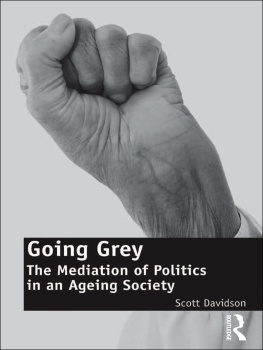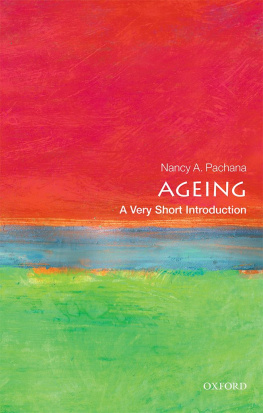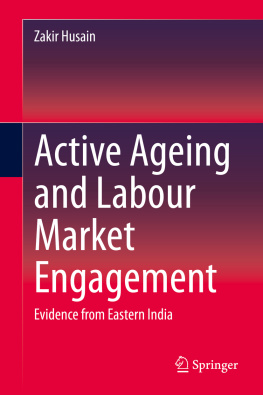GEOGRAPHIES OF AGEING
International Population Studies
Series Editor: Professor Philip Rees,
School of Geography, University of Leeds, UK
This series provides an outlet for integrated and in-depth coverage of innovative research on population themes and techniques. International in scope, the books in the series will cover topics such as migration and mobility, advanced population projection techniques, microsimulation modeling, life course analysis, demographic estimation methods and relationship statistics.
The series will include research monographs, edited collections, advanced level textbooks and reference works on both methods and substantive topics. Key to the series is the presentation of knowledge founded on social science analysis of hard demographic facts based on censuses, surveys, vital and migration statistics.
Other titles in this series:
Demography at the Edge
Remote Human Populations in Developed Nations
Edite by Dean Carson, Rasmus Ole Rasmussen, Prescott Ensign,
Lee Huskey and Andrew Taylor
ISBN 978-0-7546-7962-2
Educational Opportunity
The Geography of Access to Higher Education
Alexander D. Singleton
ISBN 978-0-7546-7867-0
Geographies of Ageing
Social Processes and the Spatial Unevenness of Population Ageing
AMANDA DAVIES
Curtin University, Australia
and
AMITY JAMES
University of Queensland, Australia
First published 2011 by Ashgate Publishing
Published 2016 by Routledge
2 Park Square, Milton Park, Abingdon, Oxon OX14 4RN
711 Third Avenue, New York, NY 10017, USA
Routledge is an imprint of the Taylor & Francis Group, an informa business
Copyright 2011 Amanda Davies and Amity James
Amanda Davies and Amity James have asserted their right under the Copyright, Designs and Patents Act, 1988, to be identified as the authors of this work.
All rights reserved. No part of this book may be reprinted or reproduced or utilised in any form or by any electronic, mechanical, or other means, now known or hereafter invented, including photocopying and recording, or in any information storage or retrieval system, without permission in writing from the publishers.
Notice:
Product or corporate names may be trademarks or registered trademarks, and are used only for identification and explanation without intent to infringe.
British Library Cataloguing in Publication Data
Davies, Amanda.
Geographies of ageing : social processes and the spatial unevenness of population ageing. (International population studies)
1. Population ageingSocial aspects. 2. Population ageingEconomic aspects.
3. Age distribution (Demography) 4. Rural population.
5. Population ageingGovernment policy.
I. Title II. Series III. James, Amity.
304.61dc22
Library of Congress Cataloging-in-Publication Data
Davies, Amanda.
Geographies of ageing: social processes and the spatial unevenness of population ageing / by Amanda Davies and Amity James.
p. cm. (International population studies)
Includes bibliographical references and index.
ISBN 978-1-4094-1776-7 (hardback : alk. paper)
1. Population aging. 2. Population agingEconomic aspects. 3. Population agingCase studies. 4. LongevityEconomic aspects. I. James, Amity. II. Title.
HQ1061.D325 2011
304.61dc23
2011023632
ISBN 9781409417767 (hbk)
ISBN 9781315584362 (ebk)
Contents
List of Figures
List of Tables
About the Authors
Amanda Davies (B.Sc., Ph.D.) is a research fellow in the division of social sciences at Curtin University in Western Australia. She holds a PhD in human geography, and her work centres on investigating spatial patterns of development in rural and regional populations. Amandas research has looked at the relationship between economic diversity and community resilience, endogenous adaptation processes to externally driven socio-economic change and population adaptations to structural shifts in labour force divisions. Amandas research on population transitions has examined both younger and older populations.
Amity James (B.Sc., Ph.D.) is a research fellow in the Institute of Social Sciences at the University of Queensland. Amity is a human geographer with a particular interest in residential mobility, ageing and demography and regional development. She has undertaken research in Australia and the UK to explore factors motivating residential mobility throughout the life cycle and the differences in housing expectations between generations. Amitys PhD examined the residential mobility decisions being made by those currently entering retirement in non-metropolitan regions.
Acknowledgements
We would like to thank Curtin University for providing the financial support for this study. We would also like to thank Eliza Pickard and Mark Atkinson for their efforts in editing the manuscript.
The maps for this book were created by Xin Liu from Curtin University, with data compiled by the authors.
Chapter 1
Introduction
1.1 Introduction
Population ageing is frequently referred to as the major demographic challenge or crisis facing many countries across the world (Bartlett and Phillips, 1997, Harper, 2006, Restrepo and Rozental, 1994). The potential economic implications of population ageing have been likened to those of the 2008 global financial crisis (Promnitz, 2010). Indeed, Standard and Poors (2010a) highlighted the potential economic impact of global population ageing in their 2010 rankings of countries creditworthiness. Population ageing also has implications for the security of the labour force and demand on health care and welfare systems. Furthermore, it has implications for the social and cultural stability of places.
The current rate of population ageing is unprecedented in human history with world population projections indicating that this will be an enduring trend. Moreover, population ageing is spatially pervasive, affecting every man, women and child (United Nations Department of Economic and Social Affairs Population Division, 2001).
Population ageing is a shift in the age distribution of a population over time toward older ages (Demeny and McNicoll, 2003). In most regions of the world, ageing is caused by declining fertility and mortality rates; however, in some regions migration also plays an important role (Lutz, Sanderson and Scherbov, 2008). There are very considerable variations in ageing between regions, countries and even within countries. This spatial variability in ageing is caused by a range of social, economic, geographical, cultural and political factors, which, in turn, affect fertility and mortality rates and migration patterns.
In this book we investigate the patterns and causes of spatial variability in ageing. We consider this variability at a number of geographical scales and consider a range of methods and theories for explaining observed trends. The aim of the book is to highlight the spatial and temporal complexity in population ageing and the importance of place specific factors in driving spatial unevenness in population ageing. The findings of this study are relevant to debates informing the critical development of policy to deal with the health, workforce, housing, social and financial outcomes from population ageing.








